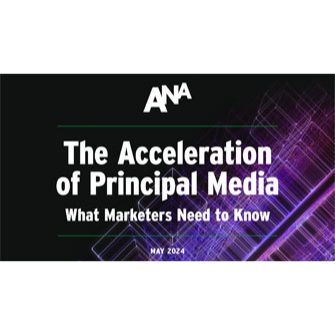Fifteen Guidelines for the Use of Principal Media

Principal media is on the rise. Changes in agency compensation models from marketers as well as pressure from marketers to extend payment terms and "drive media costs down" have led agencies and holding companies to accelerate the use of principal media. Increasingly, advertising agencies are now acting as principals rather than agents. That means they acquire media -- therefore becoming the owner, or "principal," of that media -- and resell the media to their clients. According to a member of the ANA board of directors, "While principal media can indeed provide the benefit of cost savings, marketers need to go into such deals with their eyes wide open."
A new ANA white paper, "The Acceleration of Principal Media," is intended to increase awareness and help educate marketers -- the background, benefits, challenges, and guidelines -- so they can make an informed decision about the role of principal media for them. The guidelines - 15 of them - are especially key and are recapped here.
- Marketers should consider having a formal and detailed process for approving or not approving principal media. Marketers should have a cross-functional understanding of the benefits and potential challenges of principal media. The team should establish clear policies on the company's position on and processes around principal media.
- Ensure that the contract with your agency is up to date with clear language to address principal media. Refer to section 9 of the ANA Master Media Buying Services Agreement Template Version 3.0. This is fundamental and likely the most important of these 15 guidelines.
- The agency should be required to provide a clear business case detailing why principal media is recommended overall and is consistent with the marketer's media strategy, objectives, and buying guidelines, and why it is in the best interest of the marketer. There should always be options presented that do not consist of principal media.
- There should be clear visibility into the media outlets being used in principal media deals. Marketers should know who their business partners are.
- Determine if your company is comfortable not having transparency on the cost of media to the agency, not understanding how much the agency is marking up these purchases, and the potential conflicts of interest that may arise from this model. Since most principal buys for digital media also require advertisers to accept that all tech, platform, and data costs will be bundled in the total non-transparent cost, decide if your company is also comfortable with that.
- Have a clear internal approval process for the use of principal media. Final approval should be centralized with a single, senior-level person to coordinate the company's total ongoing investments in principal media. Approvals should be done for each purchase in advance via a separate document or process.
- Require that principal media be clearly identified on media flowcharts. Do not accept vague language such as, "Principal media may be included." Require specifics.
- If your company is open to principal media, consider having a cap -- that is, it will be no more than X percent of the total budget for a specific period of time.
- Keep track of your company's allocation to principal media, both the dollar amount and percentage of overall media spending. At least quarterly, require the agency to report how much principal media is being purchased. Every new deal should include the percentage of the overall advertiser spending for the current year that has been committed to principal media.
- Except for not disclosing the price the agency paid to acquire the principal media, reporting by the agency should be provided with the same level of granularity as would be expected for agent-based transactions. Proof of performance metrics and access to transaction data should be made available for principal media with the same level of detail expected for agency-based buys.
- Auditing of principal media transactions should be allowed in the same way as for regular agency-based transactions. The only difference is that the agency would only provide access to the costs charged by the agency to the advertiser instead of the costs paid to the third-party vendors.
- Consider whether commissions or fees that would normally be paid to the agency for the management of agent-based transactions should or should not apply to principal media buys. Keep in mind that the agency will be making a profit through markups on these purchases.
- Understand the impact that principal media would have on rebates that otherwise would have been earned under a non-principal media buy.
- Don't allow the savings generated by principal media to be automatically reinvested into buying more media. Ask to buy to goals and set a reserve account with your savings. Have the agency propose how to reinvest any savings. Alternatively, return cash savings to the bottom line, if needed to meet business goals.
- When running media agency pitches, any pricing guarantees provided by the agency should be based only on agent-based transactions. If this is not required explicitly at the time of the pitch, advertisers may later find out that the agency selected will only deliver against guarantees if principal buying is allowed at the agency's discretion, essentially requiring a blanket opt-in from the advertiser.
It is imperative that marketers have guidelines for the use of principal media and go into such deals with their eyes wide open. The ANA paper is available at www.ana.net/principalmedia.
Click the social buttons to share this story with colleagues and friends.
The opinions expressed here are the author's views and do not necessarily represent the views of MediaVillage.org/MyersBizNet.


